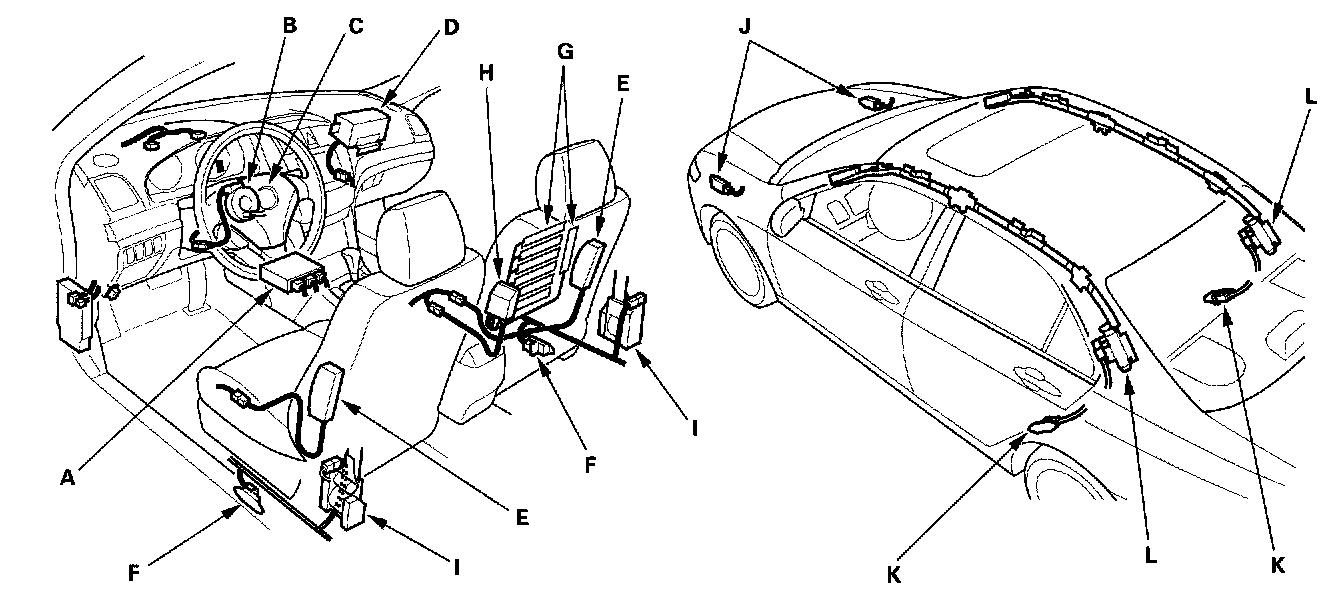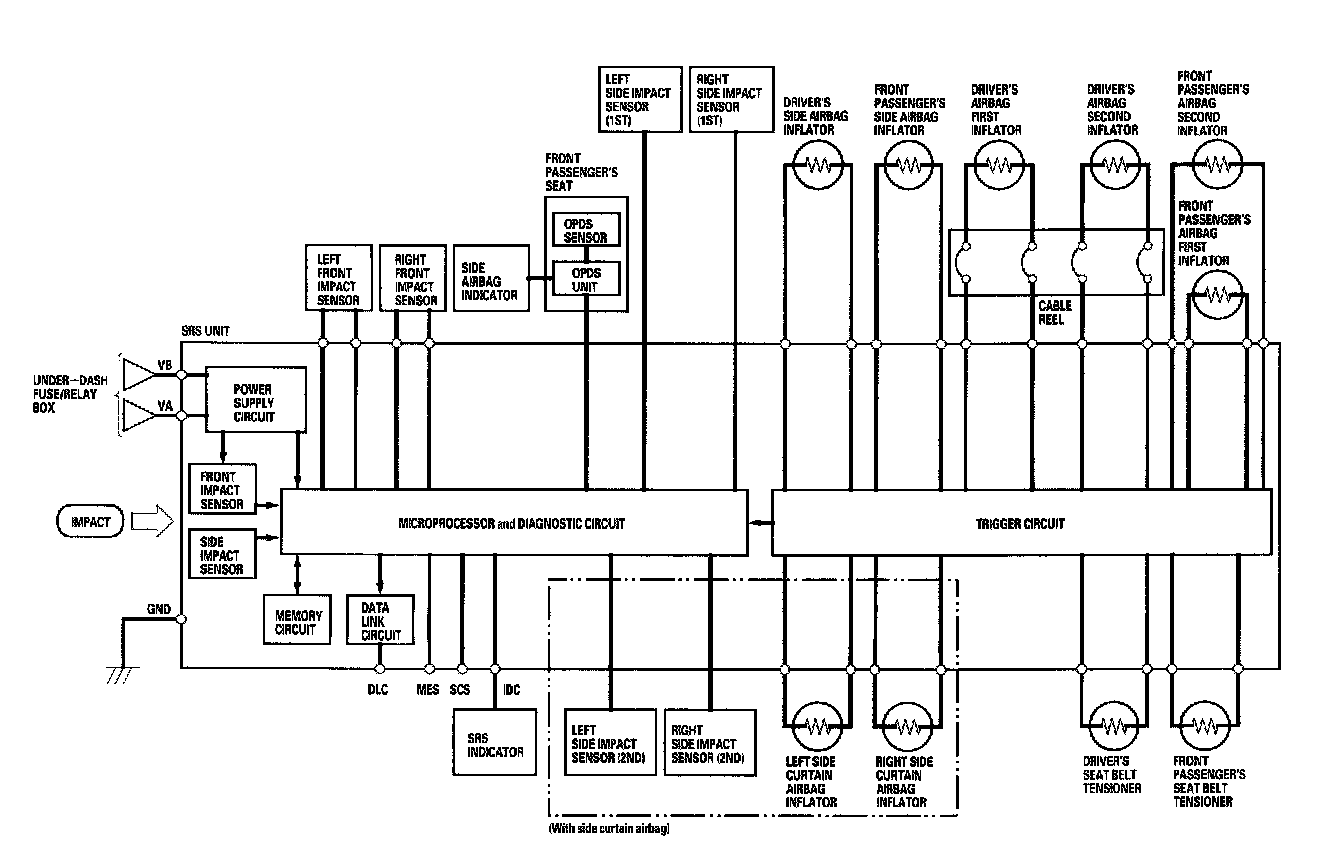Restraints and Safety Systems: Description and Operation
System DescriptionSRS Components

Airbags
The SRS is a safety device which, when used with the seat belt, is designed to help protect the driver and front passenger in a frontal impact exceeding a certain set limit. The system consists of the SRS unit, including safing sensor and impact sensor (A), the cable reel (B), the driver's airbag (C), the front passenger's airbag (D), side airbags (E), seat belt tensioners (I), and front impact sensors (J).
Side Airbags
The side airbags (E) are in each front seat-back. They help protect the upper torso of the driver or front seat passenger during a moderate to severe side impact. Side impact sensors (1st) (F) in each door sill and in the SRS unit detect such an impact and instantly inflate the driver's or the passenger's side airbag. Only one side airbag will deploy during a side impact. If the impact is on the passenger's side, the passenger's side airbag will deploy even if there is no passenger.
Side Curtain Airbags
The side curtain airbags (L) are in each side of the roof. They help protect the head of the driver, front passenger, and passengers in the rear outer seats during a moderate to severe side impact. Side impact sensors (1st) (F) in each front door sill, side impact sensors (2nd) (K) in each rear door sill, and the SRS unit detect such an impact and instantly inflate the driver's or the passenger's side curtain airbag. A side impact causes the side curtain airbag and the side airbag on the impacted side to deploy at the same time.
Seat Belt Tensioners
The seat belt tensioners are linked with the SRS airbags to further increase the effectiveness of the seat belt. In a front-end collision, the tensioners instantly retract the belt firmly to secure the occupants in their seats.
OPDS
The side airbag system also includes an occupant position detection system (OPDS). This system consists of sensors (G) and a OPDS unit (H) in the front passenger's seat-back. The OPDS unit sends occupant height and position data to the SRS unit. If the OPDS unit determines that the front passenger is of small stature (for example, a child) or the front passenger is leaning into the side airbag deployment path, the SRS unit will automatically disable the passenger's side airbag. The SRS unit will also disable the airbag when the OPDS detects certain objects on the seat. When the side airbag is disabled, the side airbag cutoff indicator on the instrument panel alerts the driver that the passenger's side airbag will not deploy in a side impact. When the object is removed, or the passenger sits upright, the side airbag cutoff indicator will go off after a few seconds, alerting the driver that the passenger's side airbag will deploy in a side impact.
SRS Operation
The main circuit in the SRS unit senses and judges the force of impact and, if necessary ignites the inflator charges. If battery voltage is too low or power is disconnected due to the impact, the voltage regulator and the back up power circuit, respectively, will keep voltage at a constant level.
For the SRS to operate
Seat Belt Tensioners
1. A front impact sensor must activate and send electric signals to the microprocessor
2. The microprocessor must compute the signals and send them to the tensioners
3. The charges must ignite and deploy the tensioners
Driver's and Front Passenger's Airbag(s)
1. A front impact sensor must activate, and send electric signals to the microprocessor
2. The microprocessor must compute the signals, and send them to the airbag inflator(s)
3. The inflators that received signals must ignite and deploy the airbags
Side Airbag(s)
1. A side impact sensor must activate, and send electric signals to the microprocessor
2. The microprocessor must compute the signals and send them to the side airbag inflator(s) However, the microprocessor cuts off the signals to the front passenger's side airbag if the SRS unit determines that the front passenger's head is in the deployment path of the side airbag
3. The inflator that received the signal must ignite and deploy the side airbag
Side Curtain Airbag(s)
1. Side impact sensors must activate, and send electrical signals to the microprocessor
2. The microprocessor must compute the signals and send them to the side curtain airbag and side airbag inflator(s)
3. The inflator that received the signals must ignite and deploy the side curtain airbag and side airbag at the same time

Side Airbag Cutoff Indicator/OPDS Operation
The indicator comes on if the front passenger's seat is occupied by a small adult or child who is leaning into the deployment path, or an object (grocery bag, briefcase, purse, etc) is in the seat This indicates the passenger's side airbag is off and will not deploy, there is no problem with the side airbag If the passenger sits upright or moves to another seat, or you remove the object from the seat the light should go off
Self-diagnosis System
A self-diagnosis circuit is built into the SRS unit; when the ignition switch is turned ON (II), the SRS indicator comes on and goes off after about 6 seconds if the system is operating normally. If the indicator does not come on, or does not go off after 6 seconds, or if it comes on while driving, it indicates an abnormality in the system. The system must be inspected and repaired as soon as possible.
For better serviceability, the SRS unit memory stores a DTC that relates to the cause of the malfunction, and the unit is connected to the data link connector (DLC). This information can be read with the HDS when it is connected to the DLC (16P)
NOTE: If the battery negative cable is to be disconnected during troubleshooting, do the following.
- Make sure you have the anti-theft code for the radio and the navigation system, then write down the frequencies for the radio's preset buttons.
- Do the engine idle learn procedure.
- Do the power window control unit reset procedure.